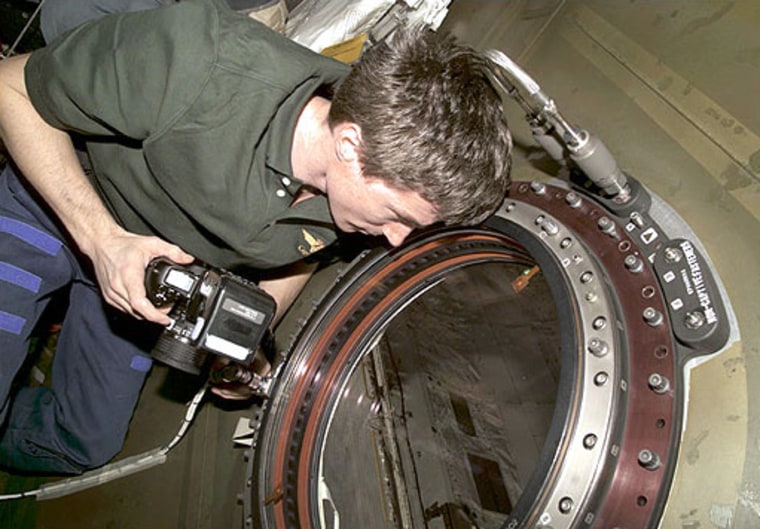The break in the pressure hose that resulted in the troublesome space station air leak was unknowingly caused over time by crew members, Russian space experts said Thursday.
NASA officials in Houston concur with that theory. Another seemingly minor error in a procedure has rendered the U.S.-built Destiny laboratory module’s main window — the best optical window ever installed in any human space vehicle — inoperative for the time being, at least until a replacement hose can be sent into space.
For two weeks, astronaut Michael Foale and cosmonaut Alexander Kaleri had searched for something wrong in the valves, windows, seals, or hull of their orbital outpost. Air was seeping out at more than five times the normal rate. Although there was no imminent threat to their health or to the station’s functioning, the small leak was a worrisome anomaly that had to be solved.
On Sunday, during what was officially off-duty time, Foale located the leak and took remedial action.
The original damage to the pressure hose was probably due to inadvertent misuse during the three years that the station has been occupied. Moscow’s Itar-Tass news agency on Thursday quoted experts at the Russian Aviation and Space Agency as saying that they believe the U-shaped hose near Destiny's main window was repeatedly bent by station crew members who used it to stabilize themselves while taking pictures out the window.
“The present crew is no more guilty than preceding ones,” the news agency quoted one Russian expert as saying. Photographs taken on board the station show crew members holding onto the loop.
NASA astronauts had not installed handholds at the window because they were waiting for the delivery of a rack assembly that was designed for installation over the window and would have provided the handholds. Due to last February's Columbia tragedy, the delivery was delayed. The assembly is now scheduled to be brought to the station on the second post-Columbia shuttle flight.
Experts at NASA's Johnson Space Center were aware of the potential for a leak in the hose, and acknowledge that they weren't as quick to pinpoint the source of the leak as they might have been. NASA documentation clearly states, “If there is damage to the Window Flexhose, remove it to stop leaking to space.”
What the hose does
The hose normally connects two air valves (called “ports”) on the rim of the window. One runs into the volume between the two fused silica pressure panes, and the other vents directly into open space. This prevents moist air from accumulating between the panes and creating condensation. Besides degrading the view, notes a NASA reference document, “moisture accelerates flaw growth” in the 1¼-inch-thick panes.
Moscow Mission Control Center official Viktor Blagov told Itar-Tass that Russian space vehicles use a different design. Since the 1970s, he explained, all windows on human space vehicles use super-dry nitrogen gas injected between the different panes and sealed there. The windows in the Russian segment of the space station are also built this way, he continued. As a result, he concluded, “the window would not become covered with moisture even at lowest temperatures.”
But the U.S. window is vulnerable to exactly that problem. According to air-to-ground conversations monitored privately, on Tuesday the crew noticed moisture between the two window panes. The crew reportedly requested permission to reconnect the damaged hose for a few minutes to vent that air into space. Instead, Mission Control in Houston gave them an alternate procedure using an undamaged, longer service hose to another vacuum port.
NASA spokesperson Kylie Moritz in Houston said she was unable to verify that the crew had spotted moisture, but did confirm that air had inadvertently leaked into the interpane area on Sunday. “Their first priority was in stopping the leak,” she explained.
Where the moisture came from
According to an MSNBC.com source, this moisture-bearing air had originally been introduced into the interpane volume because of a trivial crew error. They disconnected the leaky flex hose incorrectly on Sunday, when they first located the leak. The crew should have first disconnected the end attached to the port to the interpane volume, sealing it off, and then quickly unhooked the line from the other port, the one leading to vacuum. Instead, they unhooked the vacuum port first, so for a brief moment cabin air was sucked through the tube into the interpane space which until then had been at a vacuum.
This introduced air, moisture, dust and microbes into this volume. To prevent condensation and microbial growth, the crew was then told to close the window’s outer shutter. And although the interpane depressurization had originally been planned for Thursday, MSNBC.com has obtained a copy of NASA’s official-use-only daily status report that says the action has been “deferred to a later date, because of concerns about flash condensation.”
“The activity will probably have to await the arrival of the new jumper on Progress 13P,” the internal report continued, referring to a Russian robot supply mission to be launched at the end of January.
In the meantime, the window’s external shutter remains closed to protect it for its future primary purpose of remote sensing. The window is unavailable for Earth surface photography. The possibility of some irreversible degradation of its optical properties from the contamination remains under study.
